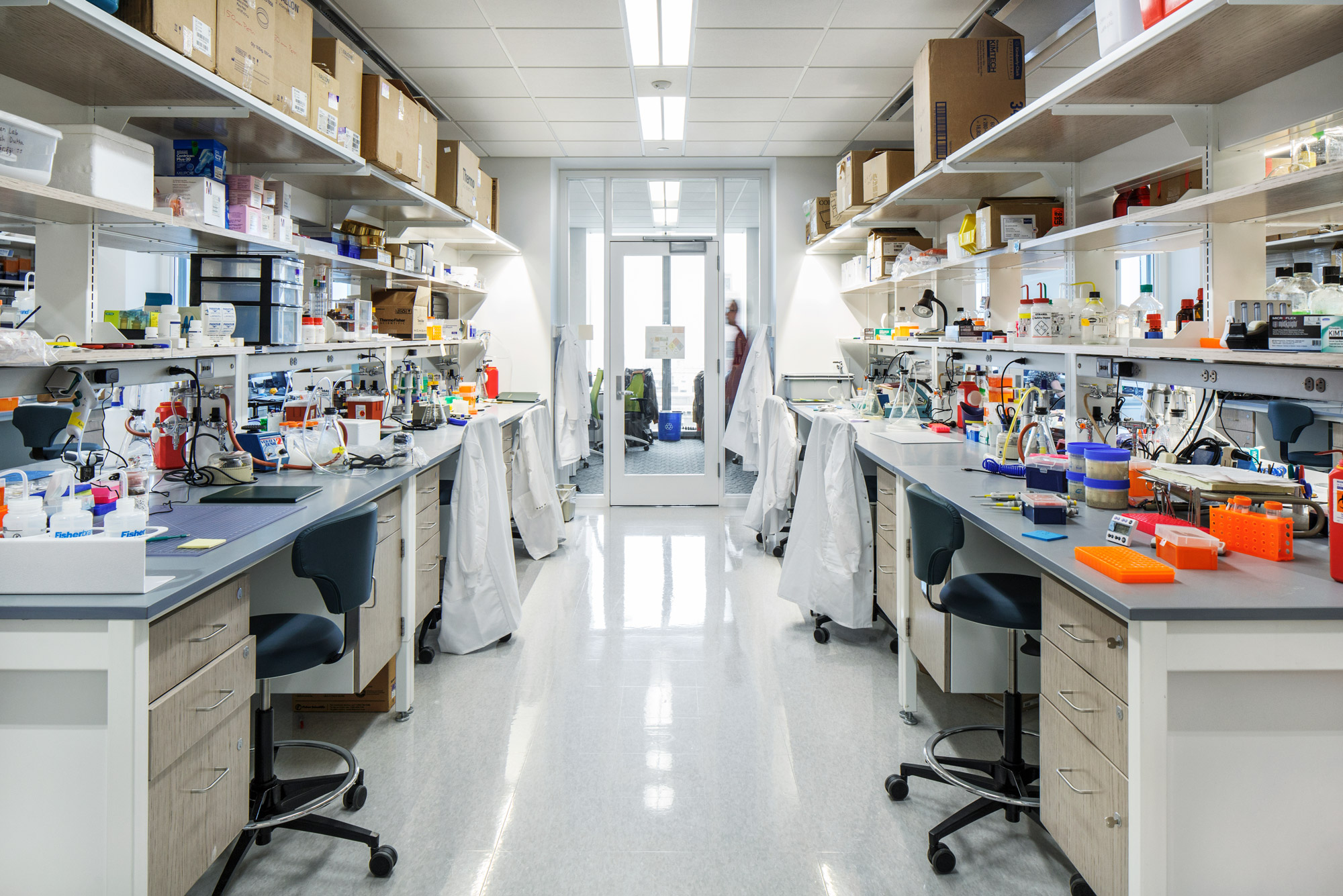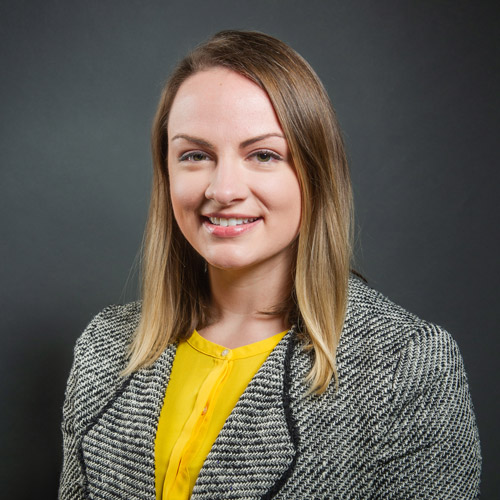BU Unveils First Phase of Campuswide Research Recovery Plan

BU’s Rajen Kilachand Center for Integrated Life Sciences & Engineering, like most of the University’s research buildings, has largely been vacant since all but essential work was banned by Governor Charlie Baker. Photo by Bob O’Connor for Boston University Photography
BU Unveils First Phase of Campuswide Research Recovery Plan
Gloria Waters, VP of research, says ramping up on-campus lab work will be gradual and contingent on public health advisories
The road to recovering Boston University’s vast research activities—which last fiscal year drew nearly $580 million in funding—will begin with a plan for “low-density” occupancy of University lab spaces, with no more than one-third of the research workforce remobilizing on campus after the Massachusetts statewide ban on nonessential work lifts, according to newly developed guidelines from BU’s Office of Research.
BU’s research recovery plan—outlined in a May 6 memo from Gloria Waters, vice president and associate provost for research, and emailed to the University faculty—will require the use of mandatory face masks, taped-off workspaces to enforce at least six feet of space between each researcher, and rapidly implementable contingency plans for quashing on-campus activity should any sign appear that the SARS-CoV-2 coronavirus, which has so far been responsible for more than 3.5 million COVID-19 infections worldwide, has reinfiltrated BU’s research community.
Other requirements will include principal investigators to submit lab-specific recovery plans, building coordinators to assess foot traffic patterns, and no in-person meetings or gatherings to be held. One of the complicating factors will be handling common building spaces where it’s difficult for people to avoid passing, comingling, or simply being in close proximity to each other.
“People should only plan to come into labs to do the specific tasks they need to do there,” Waters says. “Meetings should be held remotely, and work schedules for team members needing to come to campus will need to be staggered. Our hope is that this goes well, and the larger COVID recovery effort goes well in a greater sense in Boston, so that we can gradually increase the number of people and research activities on campus.”
It’s been nearly two months since BU’s Office of Research first rushed to shut down all nonessential laboratory activities on its Charles River and Medical Campuses. While essential on-campus research, like the coronavirus studies being done at BU’s National Emerging Infectious Diseases Laboratories, has carried on under strict social distancing measures, the majority of BU’s 4,000-plus researchers—who comprise art historians, bioinformaticists, chemists, engineers, marine biologists, neuroscientists, physicists, theologians, zoonoses scientists, and every kind of expert in between—have been relegated to working remotely.
The most complex part will be coordinating across different research groups—we have to worry about all the common spaces, services, and core facilities. That’s the biggest logistical part of this.
The launch of the research recovery plan, which has been in the works since labs first shuttered in March, comes less than two weeks before Governor Charlie Baker’s Massachusetts-wide ban on nonessential business is set to expire on May 18, and as public health data indicate that Boston’s peak of symptomatic coronavirus cases may have already passed.
In her memo, Waters called for BU’s principal investigators, lab heads, and center and core directors to draft careful recovery plans and detailed personnel lists for each laboratory, using digital templates developed by the Office of Research, and submitting their plans to the University by an initial deadline of Monday, May 11. To assist with that process, the Office of Research has created a recovery toolkit, which details the steps that lie ahead and lays a roadmap for navigating the recovery process.
Her team and University leadership advise that the complete recovery of BU research activities will unfold much more slowly than the sudden, decisive shutdown that occurred in March. “We anticipate we will begin phasing back on-campus research only after the ban on nonessential business has been lifted by [the state of Massachusetts], and from there we will begin a staged process that may take weeks or months,” Waters wrote in her memo.
To slowly trickle on-campus research back into action, the Office of Research will approve recovery plans based on a set of priorities, such as evaluating which lab groups are able to resume scientific activity without increasing the risk of community viral transmission, or whose work stands to make potentially life-saving contributions to the coronavirus pandemic. The lab-specific research recovery plans due May 11 will then be comprehensively studied by BU’s research leadership, tallying up to a bigger picture of how multiple labs might function together in the same buildings or using the same core equipment or common areas.
“The most complex part will be coordinating across different research groups—we have to worry about all the common spaces, services, and core facilities. That’s the biggest logistical part of this,” Waters says. That 30,000-foot view, however, won’t be possible to imagine until each lab that wishes to resume work has submitted detailed plans for how they propose to do so. Filling out the plans, she says, “might seem burdensome, but all the information we’re asking for is needed by the Office of Research and by other areas of the University—for example, the facilities team needs to know which rooms and spaces will become active again.”
A little further down the road, once the Office of Research is ready to grant approvals for some labs to restart lab work in minimized fashion, green lights will be given—but without long-term guarantees. Waters says the overall research recovery plan—and each individual lab plan—must bake in ample preparedness for “the real possibility that we may need to ramp down research again” in a rapid manner, should any signs appear that coronavirus has infected any of BU’s research personnel.
To keep that threat at bay, the Office of Research is advising that any researchers who are able to work remotely should continue to do so, indefinitely for now. When drafting their initial research recovery plans, lab leaders should plan for the bare minimum number of individuals to resume on-campus work—less than one-third of a lab group, to adhere to University guidelines—and should plan to stagger individuals’ work schedules and employ physical distancing measures inside lab spaces to reduce all possible chances of viral transmission.
As a guideline, the Office of Research recommends that labs reduce the density of their personnel to no greater than one-third of their original capacity, accounting and accommodating for the individual circumstances of each lab member to determine which personnel are most able to safely resume campus work. Junior researchers, including untenured faculty, postdoctoral researchers, and doctoral students, should be given priority access to on-campus work to minimize the pandemic’s impact on their career progress, Waters says.
Waters and her team are also acknowledging that collectively, the scientific community is in uncharted territory, and laboratory leaders should lean upon their professional networks and mentors at BU and beyond to crowdsource the best possible strategies for a staggered return to work. The University’s coronavirus recovery task forces are still actively working to develop broader plans to protect the entire BU community in the coming months, evaluating options for community testing, use of face masks, and policies for supporting community members who are not yet ready to return to campus based on their own individual circumstances.
Here are the biggest takeaways from the research recovery guidelines and process outline:
1. Every step of the way will be guided by the most up-to-date public health advisories—permission to resume work will be contingent on the state of Massachusetts lifting its ban on nonessential business, and the University determining it is ready to do so.
2. Reviewing the lab-specific research recovery plans submitted by principal investigators, the Office of Research will consult with department chairs, center directors, and associate deans of research to determine which lab groups should be approved to resume on-campus work. Building coordinators will need to be appointed to implement physical distancing protocols for common spaces.
3. Building coordinators should assess and mitigate foot traffic patterns to maximize physical distancing, adjusting the number of accessible entrances and exits and creating one-way traffic flows as necessary. They should also mark six-foot distances in lab areas, work spaces, elevators, and outdoor areas, using signage to remind individuals to keep enough distance between each other.
4. Once a lab group receives approval, those teams can immediately begin ordering needed supplies and making remote preparations for a return to campus. All researchers must comply with their group’s approved ramp-up plan—failure to do so will result in revocation of onsite privileges.
5. Lab groups must have enough PPE to resume work safely. Masks will be mandatory, and all labmates will be advised to treat their team as if every person is a potential viral carrier. Researchers should use gloves wisely—wearing them does not reduce the surface-hand-face transmission route. Clear plans for social distancing and for cleaning of shared spaces, doors, and scientific instrumentation must be adhered to.
6. In the initial phases of ramp-up, and until the University advises otherwise, no in-person meetings or gatherings will be permitted. Access to conference rooms, interactive spaces, kitchens, etc., should be restricted by building coordinators.
7. Lab groups should anticipate the possibility of illness, and understand their obligation to report illness should any personnel be infected with COVID-19 or come into close contact with someone infected with COVID-19.
8. All principal investigators will eventually need to fill out the necessary forms and templates for on-campus activity to ramp back up, even if they do not currently feel as though on-campus work is essential to their group’s research progress.
9. After a period of time, set forth by the University, principal investigators will be asked to revise their plans to gradually increase the percentage of personnel working on campus—this process will continue for each phase of ramping up until 100 percent capacity of personnel is deemed appropriate.
10. Should the University or government authority require nonessential work to suddenly cease again, principal investigators will be given a deadline for their groups to return to remote work.

Comments & Discussion
Boston University moderates comments to facilitate an informed, substantive, civil conversation. Abusive, profane, self-promotional, misleading, incoherent or off-topic comments will be rejected. Moderators are staffed during regular business hours (EST) and can only accept comments written in English. Statistics or facts must include a citation or a link to the citation.